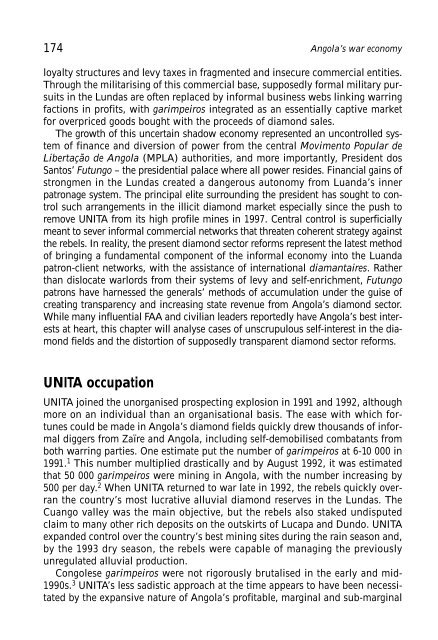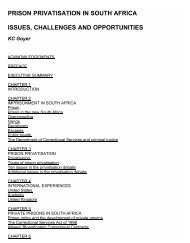Power struggles in the diamond fields - Institute for Security Studies
Power struggles in the diamond fields - Institute for Security Studies
Power struggles in the diamond fields - Institute for Security Studies
You also want an ePaper? Increase the reach of your titles
YUMPU automatically turns print PDFs into web optimized ePapers that Google loves.
174 Angola’s war economy<br />
loyalty structures and levy taxes <strong>in</strong> fragmented and <strong>in</strong>secure commercial entities.<br />
Through <strong>the</strong> militaris<strong>in</strong>g of this commercial base, supposedly <strong>for</strong>mal military pursuits<br />
<strong>in</strong> <strong>the</strong> Lundas are often replaced by <strong>in</strong><strong>for</strong>mal bus<strong>in</strong>ess webs l<strong>in</strong>k<strong>in</strong>g warr<strong>in</strong>g<br />
factions <strong>in</strong> profits, with garimpeiros <strong>in</strong>tegrated as an essentially captive market<br />
<strong>for</strong> overpriced goods bought with <strong>the</strong> proceeds of <strong>diamond</strong> sales.<br />
The growth of this uncerta<strong>in</strong> shadow economy represented an uncontrolled system<br />
of f<strong>in</strong>ance and diversion of power from <strong>the</strong> central Movimento Popular de<br />
Libertação de Angola (MPLA) authorities, and more importantly, President dos<br />
Santos’ Futungo – <strong>the</strong> presidential palace where all power resides. F<strong>in</strong>ancial ga<strong>in</strong>s of<br />
strongmen <strong>in</strong> <strong>the</strong> Lundas created a dangerous autonomy from Luanda’s <strong>in</strong>ner<br />
patronage system. The pr<strong>in</strong>cipal elite surround<strong>in</strong>g <strong>the</strong> president has sought to control<br />
such arrangements <strong>in</strong> <strong>the</strong> illicit <strong>diamond</strong> market especially s<strong>in</strong>ce <strong>the</strong> push to<br />
remove UNITA from its high profile m<strong>in</strong>es <strong>in</strong> 1997. Central control is superficially<br />
meant to sever <strong>in</strong><strong>for</strong>mal commercial networks that threaten coherent strategy aga<strong>in</strong>st<br />
<strong>the</strong> rebels. In reality, <strong>the</strong> present <strong>diamond</strong> sector re<strong>for</strong>ms represent <strong>the</strong> latest method<br />
of br<strong>in</strong>g<strong>in</strong>g a fundamental component of <strong>the</strong> <strong>in</strong><strong>for</strong>mal economy <strong>in</strong>to <strong>the</strong> Luanda<br />
patron-client networks, with <strong>the</strong> assistance of <strong>in</strong>ternational diamantaires. Ra<strong>the</strong>r<br />
than dislocate warlords from <strong>the</strong>ir systems of levy and self-enrichment, Futungo<br />
patrons have harnessed <strong>the</strong> generals’ methods of accumulation under <strong>the</strong> guise of<br />
creat<strong>in</strong>g transparency and <strong>in</strong>creas<strong>in</strong>g state revenue from Angola’s <strong>diamond</strong> sector.<br />
While many <strong>in</strong>fluential FAA and civilian leaders reportedly have Angola’s best <strong>in</strong>terests<br />
at heart, this chapter will analyse cases of unscrupulous self-<strong>in</strong>terest <strong>in</strong> <strong>the</strong> <strong>diamond</strong><br />
<strong>fields</strong> and <strong>the</strong> distortion of supposedly transparent <strong>diamond</strong> sector re<strong>for</strong>ms.<br />
UNITA occupation<br />
UNITA jo<strong>in</strong>ed <strong>the</strong> unorganised prospect<strong>in</strong>g explosion <strong>in</strong> 1991 and 1992, although<br />
more on an <strong>in</strong>dividual than an organisational basis. The ease with which <strong>for</strong>tunes<br />
could be made <strong>in</strong> Angola’s <strong>diamond</strong> <strong>fields</strong> quickly drew thousands of <strong>in</strong><strong>for</strong>mal<br />
diggers from Zaïre and Angola, <strong>in</strong>clud<strong>in</strong>g self-demobilised combatants from<br />
both warr<strong>in</strong>g parties. One estimate put <strong>the</strong> number of garimpeiros at 6-10 000 <strong>in</strong><br />
1991. 1 This number multiplied drastically and by August 1992, it was estimated<br />
that 50 000 garimpeiros were m<strong>in</strong><strong>in</strong>g <strong>in</strong> Angola, with <strong>the</strong> number <strong>in</strong>creas<strong>in</strong>g by<br />
500 per day. 2 When UNITA returned to war late <strong>in</strong> 1992, <strong>the</strong> rebels quickly overran<br />
<strong>the</strong> country’s most lucrative alluvial <strong>diamond</strong> reserves <strong>in</strong> <strong>the</strong> Lundas. The<br />
Cuango valley was <strong>the</strong> ma<strong>in</strong> objective, but <strong>the</strong> rebels also staked undisputed<br />
claim to many o<strong>the</strong>r rich deposits on <strong>the</strong> outskirts of Lucapa and Dundo. UNITA<br />
expanded control over <strong>the</strong> country’s best m<strong>in</strong><strong>in</strong>g sites dur<strong>in</strong>g <strong>the</strong> ra<strong>in</strong> season and,<br />
by <strong>the</strong> 1993 dry season, <strong>the</strong> rebels were capable of manag<strong>in</strong>g <strong>the</strong> previously<br />
unregulated alluvial production.<br />
Congolese garimpeiros were not rigorously brutalised <strong>in</strong> <strong>the</strong> early and mid-<br />
1990s. 3 UNITA’s less sadistic approach at <strong>the</strong> time appears to have been necessitated<br />
by <strong>the</strong> expansive nature of Angola’s profitable, marg<strong>in</strong>al and sub-marg<strong>in</strong>al
















